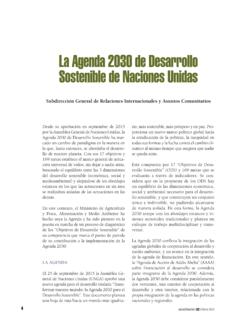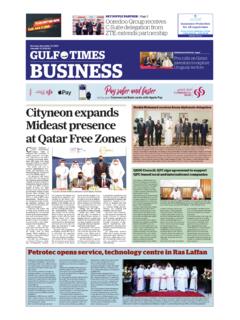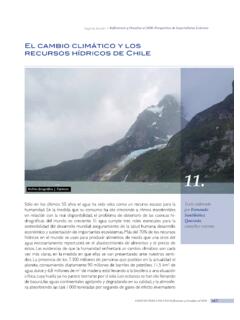Transcription of Kenya Vision 2030
1 Kenya Vision 2030. July- August, 2007. This publication is a summary of Kenya 's new long-term national planning strategy, officially known as Kenya Vision 2030. The publication briefly states the main goals of the Economic, Social and Political pillars that underpin the Vision 2030. It also provides a run-down of major, (or flagship) projects to be embarked upon in the Medium Term period of the Vision , from 2008-2012. The final version of Vision 2030 will be completed after this and other consultations. THE CONTEXT OF Kenya Vision 2030. Kenya Vision 2030 is the new country's development blueprint covering the period 2008 to 2030. It aims at making Kenya a newly industrializing, middle income country providing high quality life for all its citizens by the year 2030.
2 The Vision has been developed through an all-inclusive stakeholder consultative process, involving Kenyans from all parts of the country. The Vision is based on three pillars namely; the economic pillar, the social pillar and the political pillar. This Vision 's programme plan comes after the successful implementation of the Economic Recovery Strategy for Wealth and Employment Creation (ERS) which has seen the country's economy back on the path to rapid growth since 2002, when GDP was at rising to in 2006. The economic pillar aims at providing prosperity of all Kenyans through an economic development programme aimed at achieving an average Gross Domestic Product (GDP) growth rate of 10 % per annum the next 25 years.
3 The social pillar seeks to build a just and cohesive society with social equity in a clean and secure environment . The political pillar aims at realising a democratic political system founded on issue-based politics that respects the rule of law, and protects the rights and freedoms of every individual in the Kenyan society. The relationships between the pillars can be seen in Exhibit One below. The Kenya Vision 2030 is to be implemented in successive five-year Medium Term plans with the first such plan covering the period 2008 2012. For that reason the reader will find frequent references to projects and programmes scheduled for implementation between 2008 and 2012.
4 Currently, a detailed 5-year development plan (2008-2012) is being prepared under the coordination of the Ministry of Planning and National Development. After 2010 another five-year plan will be produced covering the period 2012 to 2017, and so on till 2030. Overarching Vision A globally competitive and prosperous nation with a high quality of life by 2030. Vi- sion Economic Social Political Strategy To maintain a A just and cohesive An issue-based, sustained society enjoying people-centered, economic growth of equitable social result-oriented, and 10% over the development in a accountable next 25 years clean and secure democratic political Plans and environment system implementation Source: NESC Vision workshop, January 13-14 2006, Naivasha, Kenya Exhibit 1: Thematic overview of the Kenya Vision 2030.
5 Page 1. THE Vision DEVELOPMENT PROCESS. The Vision 2030 development process was launched by President Mwai Kibaki on October 30th 2006. At the time, he directed that the Vision strategy be accompanied with realistic and concrete action plans to take place after ERS expires. He also advocated a consultative approach in its development involving as many ordinary Kenyans and stakeholders as possible. Consequently, this was done through workshops with stakeholders from all levels of the public service, private sector, civil society, media and non-governmental Organisations (NGOs). A number of provincial consultative forums were also held.
6 The objective of the consultations was to provide in-depth understanding of the country's development problems and the necessary strategies to achieve the 2030 results, by the people involved in the implementation of Vision 2030. To synthesize the findings, core team comprising of experienced technical officers drawn from government, research institutions, and private sector under the guidance of National Vision Steering Committee visited various firms, investors, farmers, and formal and informal business people in all the major sectors of our country. Information from the nine provincial forums during which wananchi made direct contributions to the development of the Vision , were also included.
7 Further, the team held out-of-country consultations with Kenyans overseas who have shown great interest in helping Kenya develop into a rapidly industrializing nation. The experts used all this and other information to identify sectors with the most promising potential in driving Kenya 's economic growth till 2030. The approach involved an assessment of two critical components: (i) the potential of the different sectors for economic impact; and (ii) the feasibility of unlocking that potential for the benefits of economic growth, employment and poverty - reduction. The team also looked at social and political reforms necessary to ensure that these economic goals could be realised.
8 The overall assessment of the potential for economic impact was informed by the sectors' current size and their future growth prospects. Other factors were also considered particularly the potential to increase Kenya 's competitiveness globally, to promote efficiency growth, and attract more investment locally and internationally. This analysis was based on a sound understanding of the impact each sector would make on the economy and other additional factors necessary to increase the level of resources available nationally. A similar process and methodology was followed in identifying projects and priorities in the social and political pillars.
9 Detailed analysis was carried out under a consultative process in order to come up with strategies capable of resolving the social and political problems that face Kenyans today. To arrive at workable solutions, Kenya 's experts learnt as much as they would from countries that have achieved rapid growth and also improved the lives of their people greatly in a span of 20-30 years, with particular reference to the South East Asian newly industrializing countries . The standards achieved by those countries are ones Kenya should aim for, bearing in mind her own history and culture. The team made extensive use of information available from the Government, Kenya 's private sector, civil society and universities.
10 THE ECONOMIC Vision AND STRATEGY. Under Vision 2030, Kenya aims to increase annual GDP growth rates to 10% and to maintain that average till 2030. This is an ambitious goal and the Government is aware of that. But it has the confidence that Kenyans will rise to the challenge as they have done often before. Kenya in fact will be only the 5th country in the world to achieve such a high level of sustained economic growth. Considering that the current economic growth of % has come primarily through rapid utilization of existing capacity rather than efficiency gains or much new investments, achieving the 10% growth Page 2. will require a dedicated campaign to alleviate existing constraints to future growth, and in particular to use our resources more efficiently.



